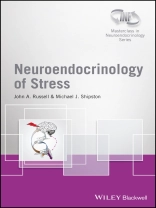Exposure to chronic stress has cumulative adverse effects on physical and mental health, considered to be the consequence of chronic exposure to high levels of stress hormones. Consequently, there is extensive research in progress to investigate and better understand how the brain organises neuroendocrine stress responses and how interventions may be able to moderate these responses to improve mental and physical health.
Neuroendocrinology of Stress highlights current knowledge of the organisation and physiology of these stress response systems, how the impact of dysregulation of these systems is being investigated, and considers the ways in which contributions to both psychiatric and physical diseases resulting from chronic stress effects can be critically addressed in basic research
* Written by a team of internationally renowned researchers, each chapter presents a succinct summary of the very latest developments in the field
* Both print and enhanced e-book versions are available
* Illustrated in full colour throughout
This is the second volume in a new Series ‘Masterclass in Neuroendocrinology’, a co- publication between Wiley and the INF (International Neuroendocrine Federation) that aims to illustrate highest standards and encourage the use of the latest technologies in basic and clinical research and hopes to provide inspiration for further exploration into the exciting field of neuroendocrinology.
Jadual kandungan
List of Contributors, vii
Series Preface, ix
Preface, xi
About the Companion Website, xv
1 Methods and Approaches to Understand Stress Processing Circuitry, 1
James P. Herman and Brent Myers
2 Brain Monoaminergic Systems in Stress Neuroendocrinology, 19
Matthew W. Hale and Christopher A. Lowry
3 The Synaptic Physiology of the Central Nervous System Response to Stress, 43
Jeffrey G. Tasker and Marian Joëls
4 Illuminating the (Electro)physiology of Anterior Pituitary Corticotrophs, 71
Lie Chen, Peter Duncan, Duncan Macgregor, Zhi Liang and Michael J. Shipston
5 Stress and Sympathoadrenomedullary Mechanisms, 95
Regina Nostramo and Esther L. Sabban
6 Neuroendocrine Mechanisms of Stress Regulation in Humans, 121
Jens C. Pruessner and Nida Ali
7 Studying Chronic Stress in Animals: Purposes, Models and Consequences, 143
Antonio Armario
8 Modelling Stress-Related Mood Disorders in Animals, 169
Mathias V. Schmidt, Klaus V. Wagner, Xiao-Dong Wang and Georgia Balsevich
9 Glucocorticoid Involvement in Drug Abuse and Addiction, 195
John R. Mantsch and Paul J. Gasser
10 The Hypothalamic-Pituitary-Adrenal Axis: Circadian Dysregulation and Obesity, 219
Andries Kalsbeek, Yan Su, Eric Fliers and Susanne la Fleur
11 Using Rodent Models to Explore the Role of 11beta-Hydroxysteroid Dehydrogenase 2 (11beta-HSD2) in Prenatal Programming by Glucocorticoids, 245
Caitlin Wyrwoll, Anjanette Harris and Megan Holmes
12 Early-Life Stress: Rodent Models, Lessons and Challenges, 265
Pamela M. Maras and Tallie Z. Baram
13 Mothering Influences on Offspring Stress Response Mechanisms, 287
Claire-Dominique Walker and Barbara Woodside
14 Translational Research in Stress Neuroendocrinology: 11beta-Hydroxysteroid Dehydrogenase 1 (11beta-HSD1), A Case Study, 327
Rebecca M. Reynolds and Scott P. Webster
Glossary, 351
Index, 369
Mengenai Pengarang
John A. Russell, University of Edinburgh, UK.
William E. Armstrong, The University of Tennessee, USA.












